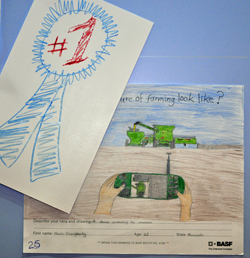If your crops could talk, what would they say?
 That was the title of a learning session at the 2014 Commodity Classic, sponsored by Ag Leader Technology, focused on using crop sensors to find out what your crops need – since they really can’t talk and tell you themselves.
That was the title of a learning session at the 2014 Commodity Classic, sponsored by Ag Leader Technology, focused on using crop sensors to find out what your crops need – since they really can’t talk and tell you themselves.
We heard from Greg Kneubuhler with G&K Concepts of Indiana, and John McGuire of Simplified Technology Services in Ohio, who made several key points when it comes to using crop sensors to ascertain plant health and determine the amount of nitrogen that plants with lower crop health need.
McGuire noted that Ag Leader did a study in 2009 that showed the advantages of using their OptRx crop sensor technology. “In that study, there was quite a range in the payback of the OptRx system,” he said. “Agronomics is the first thing that came to mind. With any precision ag pursuit, you have to have a situation where (it) can succeed.”
Kneubuhler says that means paying attention to the basics. “We come across little things that get overlooked that mask the big things that drive yield,” he said. “You have to pay attention to your basic agronomy first and don’t let it override the technology you’re using in the field.”
Both of these experts say that while there are a number of crop sensors on the market, they recommend Ag Leader’s OptRx. [wpaudio url=”http://zimmcomm.biz/agleader/classic14-agleader-optrx.MP3″ text=”Interview with Greg Kneubuhler and John McGuire on Crop Sensors”]
 Ag Leader OptRx Crop Sensor Product Specialist Chad Fick says this product has been around for six years now and growers are showing more interest as nutrient management becomes a bigger concern.
Ag Leader OptRx Crop Sensor Product Specialist Chad Fick says this product has been around for six years now and growers are showing more interest as nutrient management becomes a bigger concern.
“If we can get our management practices in place and we can have our inputs reduced, we can still increase our yields but not be wasteful and ruin the environment,” said Chad, adding that OptRx can be a helpful tool for farmers. [wpaudio url=”http://zimmcomm.biz/agleader/classic14-agleader-chad.MP3″ text=”Interview with Chad Fick, Ag Leader”]
2014 Commodity Classic Photos






 Pat tells us how they got started with the company some 4 years ago and where they look to be headed. He mentions how they started as a best control company with simulated hawks to keep other birds from bothering the grapes in wine country and now they are a full blown data company with inquiries coming from many different industries, most recently a cemetery. This information that Precision Hawk can provide can be shared and used by the grower, a seed dealer and other consultants.
Pat tells us how they got started with the company some 4 years ago and where they look to be headed. He mentions how they started as a best control company with simulated hawks to keep other birds from bothering the grapes in wine country and now they are a full blown data company with inquiries coming from many different industries, most recently a cemetery. This information that Precision Hawk can provide can be shared and used by the grower, a seed dealer and other consultants.


